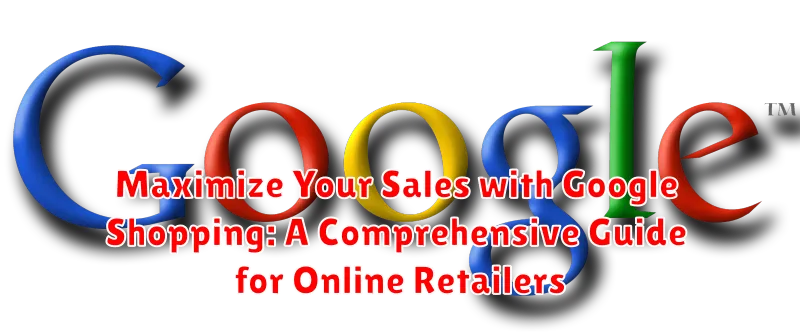In today’s competitive e-commerce landscape, leveraging every available sales channel is crucial for online retailers. Google Shopping stands as a powerful platform for showcasing products directly to potential customers actively searching for what you offer. This comprehensive guide provides online retailers with actionable strategies and insights to maximize sales through Google Shopping, covering everything from setting up your merchant account to optimizing product feeds and campaigns for optimal performance. Whether you’re a seasoned e-commerce veteran or just starting out, mastering Google Shopping can significantly impact your bottom line.
This guide delves into the intricacies of Google Shopping, providing a step-by-step roadmap to creating a high-performing campaign. Learn how to effectively manage your product data, leverage keyword research for optimal visibility, and navigate the intricacies of bidding strategies. We’ll also explore advanced techniques for campaign optimization, including utilizing Google Analytics data and exploring the power of Shopping Actions. By implementing the strategies outlined within, you’ll be well-equipped to increase your visibility, drive more traffic, and ultimately maximize your sales potential with Google Shopping.
Introduction to Google Shopping
Google Shopping offers a powerful platform for online retailers to showcase their products directly to potential customers actively searching for items to purchase. Unlike traditional text-based ads, Google Shopping displays product listings with images, prices, and store information, providing a visually compelling shopping experience.
This platform leverages the extensive reach of Google Search and other Google networks, connecting businesses with a highly engaged audience. By listing products on Google Shopping, retailers can significantly enhance their visibility and drive targeted traffic to their online stores.
Key benefits of using Google Shopping include increased brand awareness, higher click-through rates compared to text ads, and the ability to reach consumers at the precise moment they are ready to buy. The platform’s visual format allows shoppers to quickly compare products and make informed purchasing decisions.
Setting Up Your Google Merchant Center Account
Google Merchant Center is the central hub for managing your product data that fuels your Google Shopping campaigns. Setting up your account correctly is crucial for success.
First, you’ll need a Google account. If you already use Gmail or other Google services, you can use that. Otherwise, create a new one. Next, navigate to the Google Merchant Center website and click “Sign up”.
You’ll be prompted to provide information about your business, including its name, country, and website address. Carefully review and accept the terms and conditions. Claim and verify your website URL. This proves you own the website and is essential for showcasing your products on Google Shopping. Several verification methods are available, such as adding a meta tag to your website’s homepage or uploading an HTML file.
Finally, configure your shipping settings. Specify shipping rates, regions you ship to, and any applicable tax information. Accurate shipping details ensure a smooth customer experience and help avoid order cancellations.
Creating and Optimizing Your Product Feeds

Your product feed is the heart of your Google Shopping campaign. It provides Google with all the necessary information about your products, enabling them to be displayed to relevant shoppers. A well-structured and optimized feed is crucial for maximizing visibility and driving sales.
Creating a product feed involves compiling all relevant product data into a format Google can understand. Common formats include spreadsheets (like Google Sheets) and XML files. Key product attributes include a unique ID, title, description, price, availability, condition, image link, and product category.
Optimization is the key to a successful product feed. Accurately categorizing your products ensures they appear in the correct search results. Compelling product titles and descriptions rich with relevant keywords improve visibility. High-quality images showcase your products attractively, capturing shoppers’ attention.
Regularly updating your feed is essential to reflect changes in inventory, pricing, and availability. This ensures accurate information is displayed to potential customers, preventing wasted clicks and improving the overall shopping experience.
Managing Your Google Shopping Campaigns
Effectively managing your Google Shopping campaigns is crucial for maximizing your return on investment. This involves continuous monitoring, analysis, and optimization to ensure your products are reaching the right customers at the right time.
Campaign Structure: Organize your campaigns strategically. Consider structuring them by product category, brand, or even profit margin. This granular approach allows for more targeted bidding and budget allocation.
Bidding Strategies: Explore different bidding strategies offered by Google Ads. Experiment with automated bidding like “Maximize Clicks,” “Target ROAS,” or “Enhanced CPC” to find the strategy that best aligns with your business goals. Manual bidding offers greater control but requires more active management.
Performance Monitoring: Regularly review key metrics such as click-through rate (CTR), conversion rate, and cost-per-conversion. Identify top-performing products and areas for improvement. Utilize Google Ads reporting tools to gain valuable insights into campaign performance.
Utilizing Google Shopping Ads
Google Shopping Ads are a powerful way to showcase your products directly to potential customers searching on Google. These ads appear in a visually appealing format, featuring product images, prices, and your store name, making them highly effective in driving conversions.
Effective utilization of Shopping Ads requires a strategic approach. Bidding strategies play a crucial role in maximizing your return on ad spend (ROAS). Consider using automated bidding strategies like Maximize Clicks, Target ROAS, or Enhanced Cost-Per-Click (ECPC) based on your campaign goals.
Campaign segmentation is equally important. Divide your products into logical groups based on criteria such as brand, category, or product type. This allows for more granular control over bidding and targeting, ensuring your budget is allocated efficiently.
Regularly monitor and analyze your campaign performance. Track key metrics like click-through rate (CTR), conversion rate, and cost-per-conversion to identify areas for improvement and optimize your ads for maximum impact. Adjust bids, refine targeting, and experiment with different ad formats to continuously enhance your Shopping Ads strategy.
Leveraging Product Ratings and Reviews
Product ratings and reviews are crucial for success on Google Shopping. They provide valuable social proof, influencing purchasing decisions and boosting your product visibility.
Encourage reviews: Actively solicit reviews from satisfied customers. A streamlined process makes it easy for them to share their experiences.
Manage negative reviews: Address negative reviews professionally and promptly. This demonstrates responsiveness and a commitment to customer satisfaction. Showing you care can turn a negative experience into a positive one.
Showcase positive reviews: Highlight positive reviews in your marketing materials. Positive feedback builds trust and encourages potential customers to purchase your products.
Monitor your ratings: Regularly track your product ratings to identify areas for improvement in your products or services.
Tracking and Measuring Your Google Shopping Performance

Effectively tracking and measuring your Google Shopping campaigns is crucial for optimizing your return on investment and maximizing sales. Understanding key performance indicators (KPIs) allows you to identify areas for improvement and refine your strategies.
Start by monitoring your conversion rate. This metric reveals how effectively your campaigns are turning clicks into actual sales. A low conversion rate may indicate issues with your product listings, pricing, or website experience.
Keep a close eye on your return on ad spend (ROAS). This metric measures the revenue generated for every dollar spent on advertising. A higher ROAS indicates a more efficient campaign.
Click-through rate (CTR) is another important metric to track. A high CTR suggests your product titles and images are resonating with your target audience. Conversely, a low CTR may indicate a need to optimize your product feed.
Regularly analyze your impression share to understand your visibility within the competitive landscape. A low impression share might suggest you need to adjust your bidding strategy or budget.
Staying Up-to-Date with Google Shopping Best Practices
The Google Shopping landscape is constantly evolving. Staying ahead of the curve is crucial for maintaining a competitive edge and maximizing your return on investment. Regularly reviewing and adapting your strategies is key to success.
Subscribe to Google Merchant Center announcements. Google frequently releases updates and new features. Staying informed about these changes will allow you to take advantage of new opportunities and avoid potential pitfalls.
Engage with the Google Merchant Center Help Community. This platform provides valuable insights, troubleshooting tips, and best practice advice shared by other merchants and Google experts.
Monitor competitor strategies. Observe how your competitors structure their campaigns, optimize their product feeds, and leverage promotions. Understanding their tactics can inform your own approach and help you identify areas for improvement.
Regularly review Google’s best practices documentation. Google provides comprehensive guides and resources outlining the most effective strategies for managing and optimizing your Google Shopping campaigns. Referencing these resources frequently ensures you’re aligned with current recommendations.

